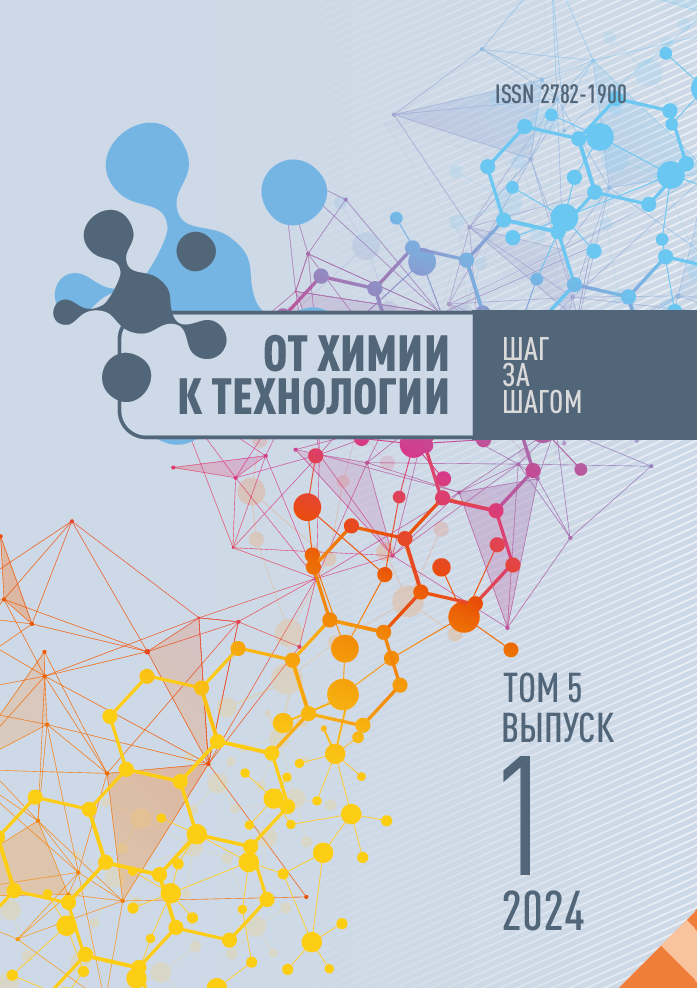Ivanovo, Ivanovo, Russian Federation
Ivanovo, Ivanovo, Russian Federation
The authors have developed new effective sorbent based on chemically modified cotton cellulose. The modification process consists of two stages, including sequential treatment of cellulose with epichlorohydrin and diethylene triamine. The authors present the optimal modification conditions for the obtained sorbent. It allows ones’ to achieve the highest values of sorption capacity for the extraction of iron(II) and copper(II) ions from aqueous solutions. The authors investigated the kinetics and equilibrium of heavy metal ion sorption in the system "cellulose sorbent - aqueous solution of metal sulphate" for original and modified cotton cellulose. Processing of the kinetic experiment results indicates that the kinetics of metal ion sorption is described most correctly in the framework of the pseudo-second-order kinetics model. Isotherms of heavy metal ions sorption clearly indicate the growth of sorption capacity for the modified sorbent in comparison with the original one. Processing of experimental isotherms within the Langmuir model made it possible to determine the values of the maximum sorption capacity (A∞) of original and modified with diethylenetriamine cotton cellulose with respect to Cu(II) and FE(II) ions. It was found that the A∞ of the modified sorbent was about 3 times higher than the ultimate sorption capacity of original cotton cellulose towards iron(II) and Cu(II) IONS. Comparison of IR spectra of the original cellulose samples and cellulose treated with diethylenetriamine indicates the changes that occurred during chemical modification. The paper presents SEM images showing the changes in the surface structure of the modified sorbent compared to the original one.
cotton cellulose, modification, diethylene triamine, sorption, ions Cu(II) and Fe(II)
1. Syeda, H.I. & Yap, P.-S. (2022) A review on three-dimensional cellulose-based aerogels for the removal of heavy metals from water, Science of the Total Environment, 807, 150606 [online]. Available at: https://doi.org/10.1016/j.scitotenv.2021.150606
2. Aldaz, B., Figueroa, F. & Bravo, I. (2020) Cellulose for the effective decontamination of water pollution, Rev. Bionatura, 5, pp. 1150–1155 [online]. Available at: https://doi.org/10.21931/RB/2020.05.02.13
3. Yadav, S., Yadav, A., Bagotia, N. & Sharma, A.K., Kumar, S. (2021) Adsorptive potential of modified plant-based adsor-bents for sequestration of dyes and heavy metals from wastewater, A review Journal of Water Process Engineering, 42, 102148 [online]. Available at: https://doi.org/10.1016/j.jwpe.2021.102148
4. Mahurpawar, M. (2020) Effects of heavy metals on human health, Ann. Trop. Med. Public Heal., 23 [online]. Available at: https://doi.org/10.36295/asro.2020.231125
5. Humelnicu, D., Lazar, M.M., Ignat, M., Dinu, I.A., Dragan, E.S. & Dinu, M.V. (2020) Removal of heavy metal ions from multi-component aqueous solutions by eco-friendly and low-cost composite sorbents with anisotropic pores, J. Haz. Mat., 381, 120980 [online]. Available at: https://doi.org/10.1016/j.jhazmat.2019.120980
6. Beni, A.-A. & Esmaeili, A. (2020) Biosorption, an efficient method for removing heavy metals from industrial effluents: A Review, Environmental Technology & Innovation, 17, 100503 [online]. Available at: https://doi.org/10.1016/j.eti.2019.100503
7. Aslam, A.A., Hassan, S.U., Saeed, M.H., Kokab, O., Ali, Z., Nazir, M.S., Siddiqi, W. & Aslam, A.A. (2023) Cellulose-based adsorbent materials for water remediation: Harnessing their potential in heavy metals and dyes removal, Journal of Cleaner Production, 421, 138555 [online]. Available at: https://doi.org/10.1016/j.jclepro.2023.138555
8. Prokof'ev, V.Yu. & Gordina, N.E. (2013) A study of thermal treatment and hydrothermal crystallization stages in production of granulated zeolite from mechanically activated metakaolin, Zhurnal Prikladnoj Khimii, 86(3), pp. 332–338. DOI:https://doi.org/10.1134/S1070427213030075 (in Russian).
9. Prokof'ev, V.Yu., Gordina, N.E. & Zhidkova, A.B. 2011.Sintez granulirovannyh ceolitov so strukturoj NAA iz kaolina, Izvestiya vysshih uchebnyh zavedenij. Seriya: Khimiya i khimicheskaya tekhnologiya, 54(12), pp. 77–80 (in Russian).
10. Burakov, A.E., Galunin, E.V., Burakova, I.V., Kucherova, A.E., Agarwal, S., Tkachev, A.G. & Gupta, V.K. (2018) Adsorption of heavy metals on conventional and nanostructured materials for wastewater treatment purposes: a review? Ecotoxicol. Environ. Saf., 148, pp. 702–712 [online]. Available at: https://doi.org/10.1016/j.ecoenv.2017.11.034
11. Nazaripour, M., Reshadi, M.A.M., Mirbagheri, S.A., Nazaripour, M. & Bazargan, A. (2021) Research trends of heavy metal removal from aqueous environments, Journal of Environmental Management, 287, 112322 [online]. Available at: https://doi.org/10.1016/j.jenvman.2021.112322
12. Nikiforova, T.E., Kozlov, V.A., Rodionova, M.V. & Modina, Ye.A. (2009) Sorption of zinc ions by products containing cellulose and protein components, Izvestiya vysshih uchebnyh zavedenij. Seriya: khimiya i khimicheskaya tekhnologiya, 52(3), pp. 27–31 (in Russian).
13. Dey, P., Mahapatra, B.S., Juyal, V.K., Pramanick, B., Negi, M.S., Paul, J. & Singh, S.P. (2021) Flax processing waste – A low-cost, potential biosorbent for treatment of heavy metal, dye and organic matter contaminated industrial wastewater, Industrial Crops & Products, 174, 114195 [online]. Available at: https://doi.org/10.1016/j.indcrop.2021.114195
14. Nikiforova, T.E., Kozlov, V.A &, Vokurova, D.A. (2023) Sorption of copper(II) ions in a heterophase system "aqueous solution - modified cellulose", Izvestiya vysshih uchebnyh zavedenij. Seriya: khimiya i khimicheskaya tekhnologiya, 66(12), pp. 91–100. DOI:https://doi.org/10.6060/ivkkt.20236612.6814 (in Russian).
15. Nikiforova, T.E. Kozlov V.A. & Loginova V.A. (2014) Peculiarities of the adsorption of heavy-metal ions from aqueous media by modified cellulose, Adsorption Science & Technology, 32(5), pp. 389–402.
16. Nikiforova, T.E., Vokurova, D.A. & Sofronov, A.R. (2022) Extraction of copper ions by a sorbent based on flax fiber modified with L-arginine, From Chemistry Towards Technology Step-By-Step, 3(3), pp. 78–86. DOI:https://doi.org/10.52957/27821900_2022_03_78 [online]. Available at: http://chemintech.ru/index.php/tor/2022tom3no3 (in Russian).
17. Anantha, R.K. & Kota, S. (2018) Bio-composites for the sorption of copper from aqueous solution: A comparative study, Groundwater for Sustainable Development, 7, pp. 265–276 [online]. Available at: https://doi.org/10.1016/j.gsd.2018.06.007
18. Nikiforova, T.E., Kozlov, V.A. & Sionikhina, A.N. (2019) Peculiarities of Sorption of Copper(II) Ions by Modified Wool Keratin, Fizikohimiya poverhnosti i zashchity materialov, 55(5), pp. 849–857 [online]. Available at: https://doi.org/10.1134/S2070205119050186 (in Russian).
19. Kokotov, Yu.A. & Pasechnik, V.A. (1970) Equilibrium and kinetics of ion exchange. L.: Khimiya (in Russian).
20. Ahnazarova, S.L. & Kafarov, V.V. (1985) Methods of Optimizing Experiments in Chemical Technology. Moscow: Vysshaya shkola (in Russian).







